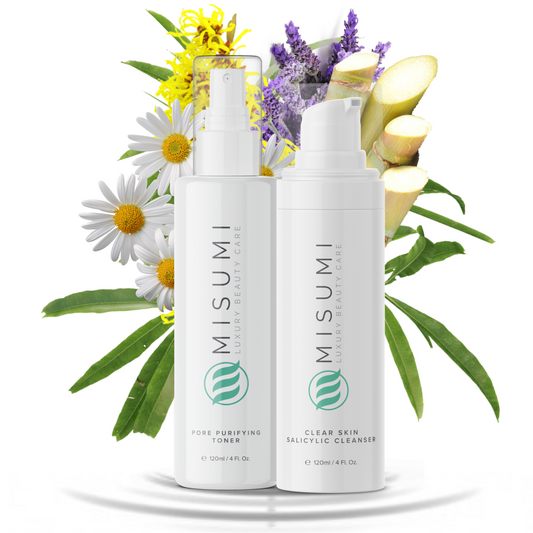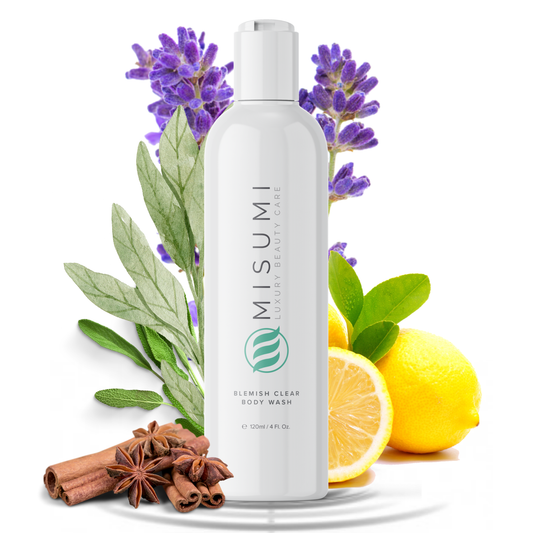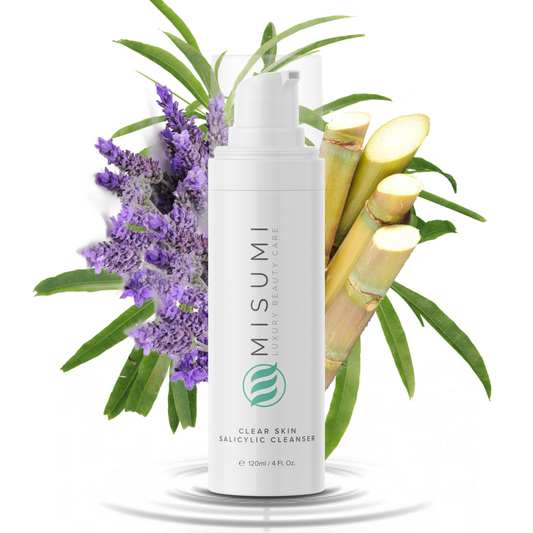There’s one fungus you surely know and love - mushrooms. But when we talk about fungus on the skin, we mean annoying infections. A fungus is a primitive organism that can live in the air, soil, water, plants, and even the human body.
You may have already noticed how some fungi can infect the body. Although fungi are not life-threatening, it's not a pleasant experience. Fungal infections are also one of the hardest infections to get rid of. The little organism survives easily in many environments and can re-infect the body once you finally get rid of it.

Many types of fungi live on the skin all the time, even though you can't see them.
There are many fungal infections, and you'll most likely find them in the lungs or on the skin. However, keep in mind that not all fungi are bad. You can find both helpful fungi and harmful fungi inside our bodies.
So, to know what you're dealing with and how to get rid of it, you need to be familiar with different fungal infections, their causes, and their symptoms. Once you know that, you can treat fungal infections effectively - for good!
Types of Fungal Skin Infections

Fungal spores are everywhere - often in the air or soil - meaning you can easily inhale them or land on them. This is why they first appear in the lungs or, more commonly, on the skin.
Let’s break down common fungal skin infections.
Tinea Versicolor (Fungal Infection of the Skin)
Tinea versicolor is a common fungal skin infection that affects pigmentation. The result may be small, discolored patches that are lighter or darker than the surrounding skin. The trunk (the chest, abdomen, pelvis, and back) and shoulders are most at risk, and the condition occurs most frequently in teens and young adults.

It can be caused by oily skin, humid, warm weather, sweaty clothes, hormones, or a weak immune system.
Symptoms include patches of skin discoloration, usually on the back, chest, neck, and upper arms. You may also develop itching and a scaly rash. The condition is not painful or contagious like other conditions, but because it’s visible, it can lead to stress, self-consciousness, and other psychological problems.
Over-the-counter antifungal creams, lotions, or shampoos can help treat tinea versicolor successfully. But even then, skin color may remain uneven for several weeks or months. Be patient, and avoid wearing tight and sweaty clothes. Let your pores breathe.
In severe cases, dermatologists prescribe topical and/or oral antifungal medication.
Tinea Cruris (Jock Itch)
Tinea cruris (or jock itch) is another common fungal infection. It belongs to the tinea family - the same group as the tinea versicolor (otherwise known as pityriasis versicolor), athlete’s foot, and ringworms. Just like the other conditions in this group, jock itch is typically harmless, but it can spread quickly and cause unpleasant symptoms.
This type of fungal skin infection is caused by mold-like fungi, known as dermatophytes, that live on the skin and thrive in warm, moist areas.

Jock itch usually develops around the groin, genital area, inner thighs, and buttocks, affecting mostly men. Sweaty clothes typically make this fungus thrive and develop symptoms.
Remember that jock itch is highly contagious, and you may get it through close personal contact with an infected person or contact with the unwashed clothing of an infected person. Obesity is also a contributing factor since the skin folds are more prone to sweating.
Symptoms of jock itch include redness, itching, burning, cracking, or skin rashes that worsen with physical activity. The good news is it’s very easy to treat - simply apply any topical, over-the-counter, antifungal product and keep the affected area clean and dry. You should feel relief and notice symptom withdrawal quickly.
Again, with severe infections, dermatologists prescribe topical and/or oral antifungal medication.
Tinea Pedis (Athlete's Foot)

This specific fungus occurs between the toes or on the foot. Athlete's foot is closely related to other fungal infections such as ringworm and jock itch.
The main symptom of athlete's foot is scaly, fungal rashes between the toes. Itching may occur while taking off the shoes or socks. Be careful since this condition is highly contagious and can spread to your hands if you scratch or touch the infected areas.
Athlete's foot is caused by wearing damp socks and shoes for a long time in warm, humid conditions. You can also get it by sharing towels or shoes - something to remember when it comes to gym locker rooms! Direct contact with someone who's infected can cause it too. Over-the-counter topical solutions for tinea pedis are available, as well as prescribed medications since athlete's foot is known to recur in severe cases.
To prevent athlete's foot, practice good foot hygiene.
Tinea Corporis (Ringworms)
Tinea corporis is a superficial fungal infection commonly found on the arms and legs, but it can also occur on other parts of the body. True to its name, a ringworm fungus infection looks like an enlarged, raised, red ring with a central, clear area. This ring-shaped rash is caused by a small fungus known as dermatophyte, which lives on the skin’s surface and can provoke a rash or an infection when the opportunity is right.
Like with athlete's foot and jock itch, you can catch ringworm if you've had direct contact with someone who's infected. Touching the belongings of someone with the infection can also spread it. A weakened immune system and excessive sweating are additional risk factors.
Most cases of this common infection can be successfully treated with over-the-counter antifungal creams, but oral medication may be the best treatment option in complicated cases. Topical antifungals are applied twice a day for at least three weeks. You should expect results after two weeks of treatment but should continue to treat the area for at least a week to ensure that the infection is completely gone.
Other common types of ringworm fungal infections are ringworm of the beard (tinea barbae) and scalp ringworm (tinea capitis).
Tinea capitis can lead to itching, redness, and even hair loss. With scalp ringworm, your doctor may take a sample of your hair. Prescription medications are usually used to treat scalp ringworm.
Tinea Unguium or Onychomycosis (Fungal Infection of the Toenails)

Tinea unguium is a fungal infection that affects the nails. It’s so common that some surveys reveal a prevalence of 10% among the adult population, more often found in males than females.
Symptoms include white or yellow thickened nails and separation of the nail from the nail bed. Even though the infection occurs in both toenails and fingernails, toenails are more likely to be affected. Having other types of fungal infections can cause this condition, but it's most closely associated with athlete’s foot.
Other things that can cause tinea unguium include having close contact with someone who is infected, a poor immune system, or peripheral vascular disease.
There are over-the-counter topical solutions and nail polishes that can do the trick. Still, the most effective treatment is antifungal medication, taken by mouth. Some researchers have associated it with liver disease. However, this review classifies them as relatively safe. In most healthy patients who don’t take other systemic medication and restrict their alcohol consumption during the treatment, oral antifungal medication comes without side effects.
Causes of Fungal Infection on the Skin

Many different types of yeasts and molds that live in the environment can trigger a fungal or yeast infection. For example, small cracks in your nail or the surrounding skin can allow the germs to enter your nail and cause it to become infected.
Some lifestyle choices may contribute to recurring fungal infections. For instance, runners may get athlete’s foot more often as they spend a lot of time sweating in their running shoes. We mentioned that fungi often grow in warm, moist environments, and wearing sweaty clothes (such as sweaty socks and even tight shoes) can increase your risk of developing a fungal infection on the skin.
Treating Fungus on the Skin

You can treat most fungal skin infections with non-prescription antifungal creams, lotions, or powders. The typical time period for application is 2 to 4 weeks before the infection disappears.
If you have an over-the-counter cream, lotion, or powder, follow the directions on the package label, and make sure you contact your healthcare provider if your infection doesn’t go away or gets worse. Some effective non-prescription products are clotrimazole, miconazole, terbinafine, and ketoconazole.
Fungal nail infections, unfortunately, can be a lot more difficult to cure. They typically don’t go away without antifungal treatment, so you should ask for medical help and prescription antifungal pills taken by the mouth. This infection can be annoying, as it can take several months to a year to go away.
Treating Skin Fungus With Home Remedies
Why spend a lot of money on treatments that might make things worse? We love home remedies because they’re safe and natural. But not only that - they are filled with vitamins and antioxidants with antibacterial and antifungal properties, which are necessary for healthy skin.
You can use them for a range of skin conditions - from getting clean and clear skin to getting rid of oily skin and even butt acne. Yep - we can find everything we need in nature. So here are the best home remedies to help treat fungus on the skin.
Garlic

Your best friend is garlic - we can’t stress this enough! Eat it, crush it, rub it on the skin, or mix it with other potent natural ingredients. Either way, garlic has the power to destroy skin fungus right away. Most importantly, it doesn't kill beneficial bacteria in the gut.
Garlic can be too strong to apply directly on the skin. So, to use it topically, you can crush two garlic cloves, add a few drops of olive oil, and make a paste. Apply the paste and leave it on for 30 minutes. Then wash the area with lukewarm water and pat your skin dry thoroughly.
You can use this treatment twice a day until you get rid of the infection.
Apple Cider Vinegar

Apple Cider Vinegar will kill the bacteria on the skin surface, speed up the recovery process and prevent the infection from spreading. You can drink or apply apple cider vinegar topically - or maybe both!
Add two tablespoons of apple cider vinegar to one cup of warm water and drink it twice a day. To use it topically, dilute apple cider vinegar with an equal amount of water and then apply it to the affected skin. Leave it for 30 minutes, then dry it with a towel.
Turmeric
Turmeric is a highly anti-inflammatory ingredient. It also contains curcumin, which has antimicrobial properties. As with the other ingredients, you can add turmeric to your daily meals to get the best results.
In addition, use it as a topical treatment by mixing it with coconut oil. Make a smooth paste and apply it to the skin. Leave it for 30 minutes to act, and then rinse it off with warm water.
Remember that turmeric can make your skin appear yellowish, but don’t worry - that will fade away in a few days.
Coconut Oil

The fatty acids in the coconut oil help with the infection by damaging the cell membranes of the fungus. This is why it's used in some skin infection products. As a natural remedy, apply coconut oil directly on the affected area three to four times a day.
It’s also an amazing moisturizer, so keep using coconut oil even after the infection is gone.
Tea Tree Oil
Tea tree oil has some powerful antibacterial and antifungal properties. It's a commonly used product for treating skin infections, as it detoxifies the infected area and reduces inflammation. You can typically use it directly on the problem area, but if you have sensitive skin, it's best to mix it with coconut oil. Apply this treatment three times a day.
Studies have been conducted on the effectiveness of tea tree oil and fungal skin infections.
Oregano Oil

Oregano oil is made from wild oregano. Most of the oregano oil on the market comes from common oregano (Origanum marjoram), so make sure you get wild oregano oil (Origanum Vulgare).
This miracle oil contains thymol and carvacrol, ingredients that can stop fungus growth. For the best results, mix it with coconut oil or water to dilute it and apply it to affected areas. Let it act on the skin for at least 30 minutes before washing it off with warm water. You can use it as much as three to four times a day.
Prevention
Recurrent infections are very common, so it's important to know how to prevent them. We mentioned that a fungal infection could be easily triggered by a normal type of fungus that lives on the skin.

It’s a good idea to use topical antifungals once or twice a month as a preventive measure to keep the fungal infection from coming back. Additionally, if you experience fungal skin infections often (such as jock itch and ringworm), it may be time to start using stronger cleansers and body washes regularly - especially if you live in warm and humid areas. Try the Blemish Clear Body Wash for a safe and effective cleanse.
Warmer places also mean more sun exposure. The sun can make your infection worse and the rash more visible. Protect yourself properly by using high-quality sunscreen with a minimum sun protection factor (SPF) of 30.
But be careful! Make sure you choose a non-greasy formula. Oily products don’t go well with fungal skin infections. You might also want to reevaluate what other skin products you’re using. Don’t wear tight clothing that might irritate the skin and cause you to sweat even more.
Don’t wait too long before you ask for medical help. Most fungal infections can be treated easily when they are diagnosed on time. And most important of all - boost your immune system! You can’t control everything you get in contact with on a daily basis, but you can help your body fight off particles in the environment that can potentially cause damage.
The Center for Disease Control and Prevention advises you:
- Always clean your shoes and keep them dry.
- Make sure your shoes are breathable, and the air can circulate freely.
- Dirty areas like locker rooms or showers are your enemy. Never walk barefoot in public places.
- Keep good hygiene on your fingernails and toenails. Your nails should always be short and clean.
- Don’t forget to change your underwear and socks daily, as this will put you at higher risk.
- Don't share your clothes or other personal items with other people.
- Wash your hands after playing with your pets.
- If you are a physically active person, shower immediately after your workout session and keep all your sports gear and uniform clean.
Conclusion
Fungal skin infections can be hard to treat at the best of times. To discourage fungal growth, make sure you follow the advice above. Skin infections can either be severely or mildly contagious. If you notice any skin changes and think you may have a fungal skin infection, it's always best to visit a doctor familiar with your medical history.









